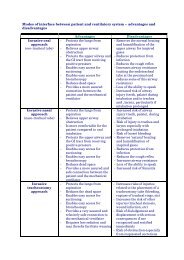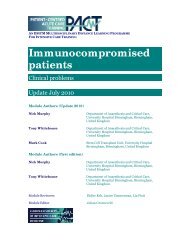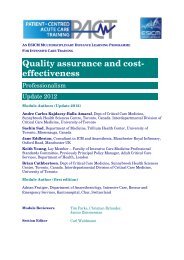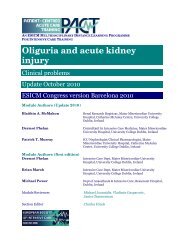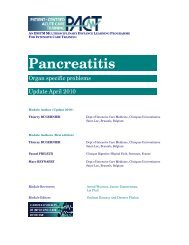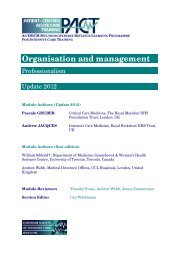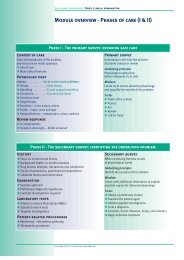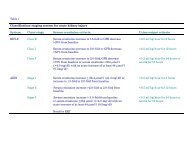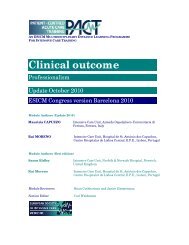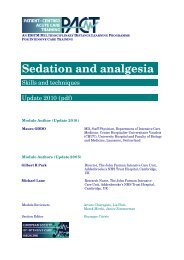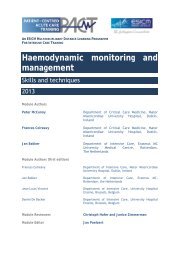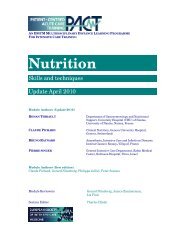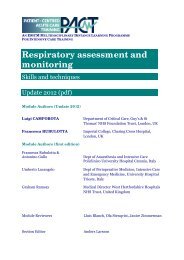Burns injury - PACT - ESICM
Burns injury - PACT - ESICM
Burns injury - PACT - ESICM
Create successful ePaper yourself
Turn your PDF publications into a flip-book with our unique Google optimized e-Paper software.
Although diagnosing CN poisoning is a challenge in the emergency setting, immediate<br />
treatment is of utmost importance. Given the fact that methods to detect and<br />
measure CN in blood are usually not readily available and that patients may often be<br />
exposed to both CO and CN, clinicians have to rely on the presenting symptoms and<br />
the general status of the patient. In patients hospitalised with a history of a fire<br />
accident, combined with severe neurological compromise (reduced Glasgow Coma<br />
Scale Score), soot particles in the mouth or from tracheal expectoration raise the<br />
suspicion of concomitant CN poisoning.<br />
Any unconscious fire victim should be considered as CO or CN poisoned in<br />
absence of any evidence of traumatic brain <strong>injury</strong> and treated as such.<br />
Pathophysiology<br />
Hydrogen cyanide (HCN) is easily absorbed from all routes of exposure. Since HCN is a<br />
small lipid soluble (mainly undissociated) molecule , distribution and penetration of<br />
HCN into cells is rapid. In most severe cases the symptoms are unconsciousness,<br />
convulsions, cardiovascular collapse followed by shock, pulmonary oedema and<br />
death. Virtually all patients with severe, acute CN poisoning die immediately.<br />
Autopsy findings include petechial, subarachnoid or subdural haemorrhages.<br />
The similarity between CO and CN is the ability to bind iron ions. However, where CO<br />
impairs the ability of erythrocytes to transfer oxygen, CN binds to erythrocytes but<br />
does not affect the oxygen transfer. The primary effect of CN is a blocking of the<br />
mitochondrial respiration chain and thereby blocking the formation of intracellular<br />
adenosine triphosphate (ATP). The result is cytotoxic hypoxia caused by the<br />
inhibition of Cytochrome C Oxidase (CCO) by the high affinity of CN to heme a3 of<br />
the enzyme. The effect is a structural change, reduced activity of the enzyme and an<br />
increase in lactate production resulting in metabolic acidosis.<br />
Treatment<br />
In the emergency setting, treatment is given based on the presumptive clinical<br />
diagnosis. Oxygen in combination with a recommended antidote should be<br />
administered immediately, the first to reduce cellular hypoxia and the second to<br />
eliminate cyanide. A specific antidote is hydroxocobalamin, which can be given<br />
intravenously (70 mg/kg via a peripheral IV line – the usually described initial dose<br />
being 5g) with nearly no side effects. Hydroxocobalamin turns the urine and<br />
sometimes skin purple. Other antagonists (nitrites and thiosulfate) can be used but<br />
are more difficult to administer.<br />
23



